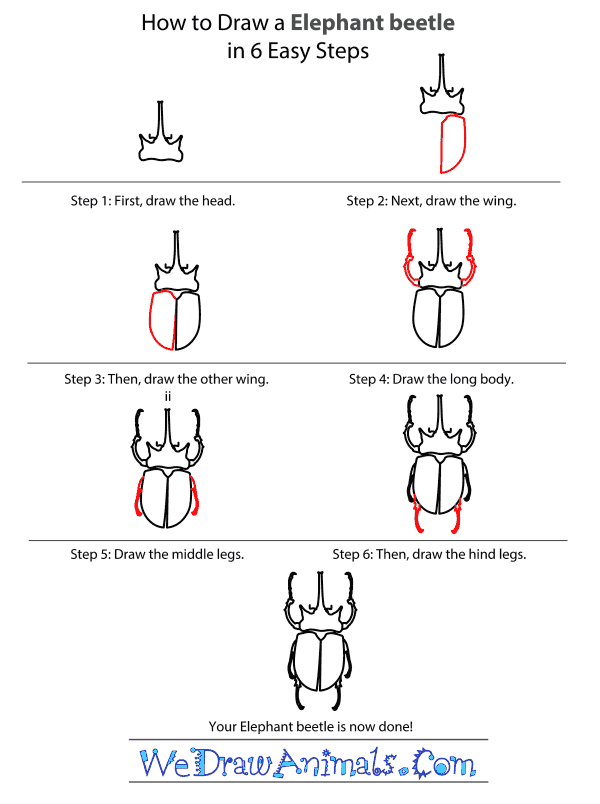In this quick tutorial you'll learn how to draw an Elephant Beetle in 6 easy steps - great for kids and novice artists.
The images above represent how your finished drawing is going to look and the steps involved.
Below are the individual steps - you can click on each one for a High Resolution printable PDF version.
At the bottom you can read some interesting facts about the Elephant Beetle.
Make sure you also check out any of the hundreds of drawing tutorials grouped by category.
How to Draw an Elephant Beetle - Step-by-Step Tutorial
Step 1: Draw the head first. Make the back of the head roughly flat, which comes up to two points as shown. Then, the two lines comes together to make one long snout
Step 2: Now draw the right wing. It's basically three straight lines with a curved portion at the end to connect them all
Step 3: Now draw the second wing, which is identical to the right, except reflected.
Step 4: Now you draw the front arms, which are thin, curved lines
Step 5: Now draw the middle legs, which are even thinner and go back.
Step 6: Finally, draw the back legs, which are the shortest and smallest of them all.
Interesting Facts about the Elephant Beetle
The elephant beetle is a giant in the insect world. It is a large tropical beetle, and the males have a long horn on their heads. Adult elephant beetles have a shiny black body with a yellowish-brown furry covering. Adult elephant beetles can grow to 8 centimeters in length and weigh up to 35 grams. Elephant beetle larva can grow from 12.5 to 22.5 centimeters in length and weigh up to 86 grams. This beetle lives in Central and South America. The adults are usually found in the forest canopy, but the larvae are usually laid in logs or stumps on the ground. The elephant beetle eats flowers, fruit, and sap.
Did you know?
- Adults are active at night and are often attracted to lights.
- Elephant beetles are able to increase their body temperature metabolically.
- Males use their horns to fight rival males over females or food.
- The larvae take two to three years to mature.
- The elephant beetle can be found at elevations up to 1,000 meters.
- Habitat loss is a threat to the elephant beetle.
Lesson plan note: Draw and cut out elephant beetles for each child. Give the children the beetles, and have them color their beetle. Put all completed beetles on the bulletin board.







